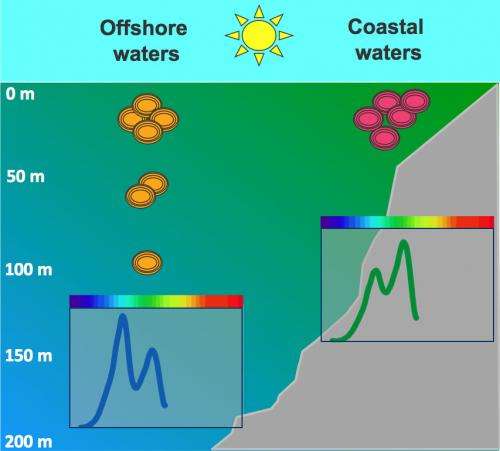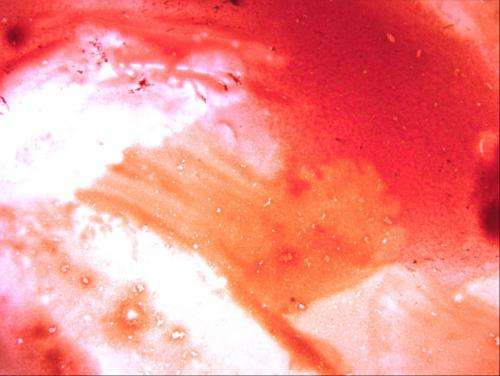Team uncovers process for chameleon-like changes in world's most abundant phytoplankton

An international team of biologists led by Indiana University's David M. Kehoe has identified both the enzyme and molecular mechanism critical for controlling a chameleon-like process that allows one of the world's most abundant ocean phytoplankton, once known as blue-green algae, to maximize light harvesting for photosynthesis.
Responsible for contributing about 20 percent of the total oxygen production on the planet, the cyanobacteria Synechococcus uses its own unique form of a sophisticated response called chromatic acclimation to fine tune the absorption properties of its photosynthetic antenna complexes to the predominant ambient light color. The researchers identified and characterized an enzyme, MpeZ, that plays a pivotal role in the mechanism that allows two different water-soluble proteins in Synechococcus—phycoerythrin I and II—to alter their pigmentation in order to maximize photon capture for photosynthesis.
Scientists want to understand how cyanobacteria optimize their photosynthetic activities in different light conditions to gain a better appreciation of how human activities affect the phytoplankton's ability to produce oxygen and uptake the greenhouse gas carbon dioxide, which they consume in order to grow. Science and industry also use the pigment-protein complex phycoerythrin for fluorescent imaging and as fluorescent markers in biotechnology and health care applications.
"We now have the ability to attach a novel chromophore, part of a molecule responsible for its color, to phycoerythrin, which provides a new chromophore-protein combination that absorbs and fluoresces at a wavelength that is not currently commercially available," said Kehoe, a professor in the IU Bloomington College of Arts and Sciences' Department of Biology. "Our results suggest that this new chromoprotein is brighter and more stable than most on the market today."
Kehoe also noted IU has begun the process of filing a patent on the invention.

The team found that the gene encoding the MpeZ enzyme is activated in blue light. Once produced, MpeZ then binds to antenna proteins containing pigments that normally catch green light and attaches an alternative chromophore that allows the antennae to capture blue light. The specific mechanism, called type IV chromatic acclimation, involves replacing three molecules of the green light-absorbing chromophore with an equal number of blue light-absorbing chromophore. This color-shifting is reversible and is controlled by the ratio of blue to green light in the environment.
"These 'chromatic adapters' are true chameleons that can efficiently live in green coastal waters as well as in blue offshore waters by modifying their pigmentation," Kehoe said. "Synechococcus cells maintained in blue light harvest preferentially blue light, while cells grown in green light harvest more green."
"A phycoerythrin-specific bilin lyase-isomerase controls blue-green chromatic acclimation in marine Synechococcus" was published online in the Early Edition of Proceedings of the National Academy of Sciences.
Journal information: Proceedings of the National Academy of Sciences
Provided by Indiana University

















